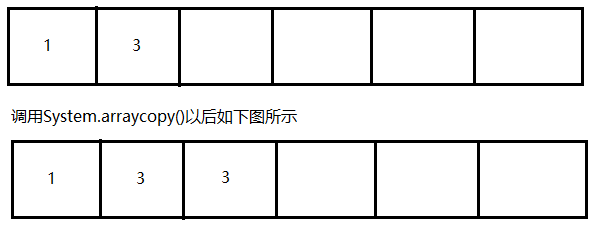1、特点:
时间换空间, 操作容器花费更多时间, 但是会减少内存;
这篇博客重点分析:
1. SparseArray;
2. SparseIntArray;
3. ArrayMap;
2、以SparseIntArray为例:
1、构造函数:
private int[] mKeys;
private int[] mValues;
private int mSize;
public SparseIntArray() {
this(10);
}
public SparseIntArray(int initialCapacity) {
if (initialCapacity == 0) {
mKeys = EmptyArray.INT;
mValues = EmptyArray.INT;
} else {
mKeys = ArrayUtils.newUnpaddedIntArray(initialCapacity);
mValues = new int[mKeys.length];
}
mSize = 0;
}
libcore/luni/src/main/java/libcore/util/EmptyArray.java--->
public final class EmptyArray {
private EmptyArray() {}
public static final boolean[] BOOLEAN = new boolean[0];
public static final byte[] BYTE = new byte[0];
public static final char[] CHAR = new char[0];
public static final double[] DOUBLE = new double[0];
public static final float[] FLOAT = new float[0];
public static final int[] INT = new int[0];
public static final long[] LONG = new long[0];
public static final Class[] CLASS = new Class[0];
public static final Object[] OBJECT = new Object[0];
public static final String[] STRING = new String[0];
public static final Throwable[] THROWABLE = new Throwable[0];
}
上面代码主要做了一件事:
- 1、创建两个数组, 分别存储key和value;
2、put():
class SparseIntArray--->
public void put(int key, int value) {
int i = ContainerHelpers.binarySearch(mKeys, mSize, key);
if (i >= 0) {
mValues[i] = value;
} else {
i = ~i;
mKeys = GrowingArrayUtils.insert(mKeys, mSize, i, key);
mValues = GrowingArrayUtils.insert(mValues, mSize, i, value);
mSize++;
}
}
class ContainerHelpers--->
static int binarySearch(int[] array, int size, int value) {
int lo = 0;
int hi = size - 1;
while (lo <= hi) {
final int mid = (lo + hi) >>> 1;
final int midVal = array[mid];
if (midVal < value) {
lo = mid + 1;
} else if (midVal > value) {
hi = mid - 1;
} else {
return mid;
}
}
return ~lo;
}
class GrowingArrayUtils --->
public static int[] insert(int[] array, int currentSize, int index, int element) {
assert currentSize <= array.length;
if (currentSize + 1 <= array.length) {
System.arraycopy(array, index, array, index + 1, currentSize - index);
array[index] = element;
return array;
}
int[] newArray = new int[growSize(currentSize)];
System.arraycopy(array, 0, newArray, 0, index);
newArray[index] = element;
System.arraycopy(array, index, newArray, index + 1, array.length - index);
return newArray;
}
public static int growSize(int currentSize) {
return currentSize <= 4 ? 8 : currentSize * 2;
}
put主要做了下面几件事:
- 1、插入操作先通过二分查找, 找出key. 二分查找时间复杂度为O(logN); 而HashMap内部维护的是一个数组, 查找时间复杂度为O(1); 所以就插入操作来说, HashMap会更快一些;
- 2、这个二分查找进行的挺巧妙的, 插入失败返回~lo; 对返回值再继续进行取反操作;
- 3、然后依次将key和value插入到数组中去, 我们看看他的插入操作;
- 4、假设我们插入操作一直是乱序的, 并且很频繁, 会出现什么问题? 二分查找频繁执行. 每次都是O(logN), 如果数据量过大, 与HashMap O(1)比起来时间差距就会越来越明显;
- 5、System.arraycopy(array, index, array, index + 1, currentSize - index)与array[index] = element;这两步操作就是将我们要插入的元素插入到指定位置. 画个图
2、get():
public int get(int key, int valueIfKeyNotFound) {
int i = ContainerHelpers.binarySearch(mKeys, mSize, key);
if (i < 0) {
return valueIfKeyNotFound;
} else {
return mValues[i];
}
}
**查找就很简单了, 因为在put方法执行时的一系列操作可以保证数组是有序的, 所以查找的时间复杂度也是O(logN). ** 所以如果涉及到大数据量或者查找特别频繁的操作, SparseArray系列并不适用;
3、delete():
public void delete(int key) {
int i = ContainerHelpers.binarySearch(mKeys, mSize, key);
if (i >= 0) {
removeAt(i);
}
}
public void removeAt(int index) {
System.arraycopy(mKeys, index + 1, mKeys, index, mSize - (index + 1));
System.arraycopy(mValues, index + 1, mValues, index, mSize - (index + 1));
mSize--;
}
删除操作也是挺简单的, 时间复杂度也是为O(logN). 因为他进行的数组元素的整体拷贝. 与get方法一样, 当删除操作特别频繁或者数据量很大时, 也是没必要使用的;
综上所述:
当涉及到数据量不是特别大时, 官方给出的建议是千以下, 并且操作不是特别频繁时, 使用SparseArray系列. 因为它可以节省内存空间, APP与Windows不一样, 虚拟机为每个APP分配的内存空间很有限, SparseArray主要从以下几个方面节省内存空间:
- 1、没有自动装箱的操作;
- 2、没有Entry对象;及其Hash映射关系;
